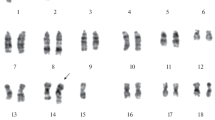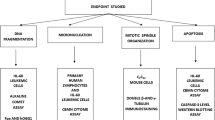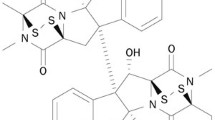Summary
Previous studies using the mutant Chinese hamster ovary cell line VpmR-5 indicate that its resistance to mediated through a qualitative change in type II topoisomerase that confers resistance to drug-stimulated DNA cleavage activity. In a further investigation of the genetic basis of drug resistance in VpmR-5 cells, we fused a hypoxanthine-guanine phosphoribosyl transferase-deficient subline of VpmR-5 (Vtgm-6) with normal human lymphocytes and analyzed the resultant hybrid lines (HL) for altered drug sensitivity. In all, 3 of 16 hybrid clones exhibited partial reconstitution of sensitivity to etoposide, mitoxantrone, doxorubicin, and 5-iminodaunorubicin while retaining complete resistance tom-AMSA. However, enhanced sensitivity to drug-induced DNA cleavage activity was observed only for etoposide. Biochemical and molecular-marker analysis of the hybrids failed to identify human chromosome 17 (the provisional location ofTOP2) or any other human chromosome that is consistently and uniquely associated with drug sensitivity. We therefore sought to verify the chromosomal assignment ofTOP2 by Southern blot hybridization ofTOP2 cDNA on a human hybrid mapping panel and confirmed its location on chromosome 17. However, no hybridizing sequence to theTOP2 cDNA was found in any of the 16 Vtgm-6 hybrid lines. Efforts to select more directly for human chromosome 17 VpmR-5 hybrids using microcell fusion of mouse A9 cells carrying human 17 linked to pSV2neo were unsuccessful. None of the five hybrid clones thus obtained had 17q markers, including the gene forTOP2. Although the mechanism underlying partial reversion to a drug-sensitive phenotype in the original Vtgm-6 hybrid lines has yet to be defined, the data obtained in these lines indicate that anthracycline- and anthracenedione-induced cytotoxic effects can be dissociated from DNA cleavage activity. This suggests that pathways distal to cleavable-complex formation or, alternatively, independent of interactions with topoisomerase II that involve other intracellular targets are important in mediating the cytotoxicity produced by these drugs.
Similar content being viewed by others
Abbreviations
- m-AMSA:
-
4′,9-acridinylaminomethanesulfon-m-anisidide
- CHO:
-
Chinese hamster ovary
- HPRT:
-
hypoxanthine-guanine phosphoribosyl transferase
- WT:
-
wild type
- DMSO:
-
dimethylsulfoxide
- HAT:
-
hypoxanthine (100 μm), aminopterin (10 μm), thymidine (10 μm)
- HEPES:
-
hydroxylethyl piperazine ethanesulfonic acid
- SDS:
-
sodium dodecyl sulfate
- TBS:
-
TRIS (20mm, pH 7.5) plus NaCl (550mm)
- TTBS:
-
TBS plus 0.05% Tween-20
References
Amasino RM (1986) Acceleration of nucleic acid hybridization rate by polyethylene glycol. Anal Biochem 152: 304
Bakic M, Beran M, Andersson BS, Silberman L, Estey E, Zwelling LA (1986) The production of topoisomerase II-mediated DNA cleavage in human leukemia cells predicts their susceptibility to 4′-(9-acridinylamino)-methanesulfon-m-anisidide (m-AMSA). Biochem Biophys Res Commun 134: 638
Berlin V, Haseltine WA (1981) Reduction of Adriamycin to a semiquinone-free radical by NADPH cytochrome P-450 reductase produces DNA cleavage in a reaction mediated by molecular oxygen. J Biol Chem 256: 4747
Chow KC, Ross WE (1987) Topoisomerase-specific drug sensitivity in relation to cell cycle progression. Mol Cell Biol 7: 3119
Chow KC, King CK, Ross WE (1988) Abrogation of etoposide-mediated cytotoxicity by cycloheximide. Biochem Pharmacol 37: 1117
Davidson R, O'Malley K, Wheeler TB (1976) Polyethylene glycol-induced mammalian cell hybridization: effect of polyethylene glycol molecular weight and concentration. Somatic Cell Mol Genet 2: 271
Davies SM, Robson CN, Davies SL, Hickson ID (1988) Nuclear topoisomerase II levels correlate with the sensitivity of mammalian cells to intercalating agents and epipodophyllotoxins. J Biol Chem 236: 17724
Davies SM, Robson CN, Davies SL, Hoban PR, Harris AL, Hickson ID (1988) Isolation of CHO cell lines hypersensitive to Adriamycin: identification of abnormalities in topoisomerase II and drug transport (abstract). Proc Am Assoc Cancer Res 29: 277
Edwards CM, Glisson BS, King CK, Smallwood-Kentro S, Ross WE (1987) Etoposide-induced DNA cleavage in human leukemia cells. Cancer Chemother Pharmacol 20: 162
Estey E, Adlakha RC, Hittelman WN, Zwelling LA (1987) Cell cycle stage dependent variations in drug-induced topoisomerase II mediated DNA cleavage and cytotoxicity. Biochemistry 26: 4338
Fournier REK, Ruddle FH (1977) Microcell mediated transfer of murine chromosomes into mouse Chinese hamster and human somatic cells. Proc Natl Acad Sci USA 74: 319
Friend KK, Dorman BP, Kucherlapati RS, Ruddle FH (1976) Detection of interspecific translocations in mouse-human hybrids by alkaline Giemsa staining. Exp Cell Res 99: 31
Gillin FD, Roufa DJ, Beaudet AL, Castrey CT (1972) 8-Azaguanine resistance in mammalian cells: hypoxanthine-guanine phosphoribosyl transferase. Genetics 72: 239
Glisson B, Gupta R, Smallwood-Kentro S, Ross W (1986) Characterization of acquired epipodophyllotoxin resistance in a Chinese hamster ovary cell line: loss of drug-stimulated DNA cleavage activity. Cancer Res 46: 1934
Glisson B, Gupta R, Hodges P, Ross W (1989) Cross-resistance to intercalating agents in an epipodophyllotoxin-resistant Chinese hamster ovary cell line: evidence for a common intracellular target. Cancer Res 46: 1939
Glisson BS, Ross WE (1987) DNA topoisomerase II: a primer on the enzyme and its unique role as a multidrug target in cancer chemotherapy. Pharmacol Ther 32: 89
Gupta RS (1983) Genetic, biochemical, and cross-resistance studies with mutants of Chinese hamster ovary cells resistant to the anticancer drugs, VM-26 and VP16-213. Cancer Res 43: 1568
Harper ME, Barrera-Saldana HA, Saunders GF (1982) Chromosomal localization of the human placental lactogen-growth hormone gene cluster to 17q22-24. Am J Hum Genet 34: 227
Killary AM, Fournier REK (1984) A genetic analysis of extinction: trans-dominant loci regulate expression of liver-specific traits in hepatoma hybrid lines. Cell 38: 523
Kohn KW, Erickson LC, Ewig RAG, Friedman CA (1976) Fractionation of DNA from mammalian cells by alkaline elution. Biochemistry 14: 4637
Leach RJ, Thayer MJ, Schafer AJ, Fournier REK (1989) Physical mapping of human chromosome 17 using fragment containing microcell hybrids. Genomics 5: 167
Long BH, Musial ST, Brattain MG (1984) Comparison of cytotoxicity and DNA breakage activity of congeners of podophyllotoxin including VP16-213 and VM26: a quantitative structure-activity relationship. Biochemistry 23: 1183
McAlpine PJ, Shows TB, Boucheix C, Stranc LC, Berent TG, Pakstis AJ, Doute RC (1989) Report of the nomenclature committee and the 1989 catalog of mapped genes. Cytogenet Cell Genet 51: 13
Pommier Y, Schwartz RE, Zwelling LA, Kerrigan D, Mattern MR, Charcosset JY, Jacquemin-Sablon A, Kohn KW (1986) Reduced formation of protein-associated DNA strand breaks in Chinese hamster cells resistant to topoisomerase II inhibitors. Cancer Res 46: 611
Siciliano MJ, White BF (1987) Isozyme identification of chromosomes in interspecific somatic cell hybrids. Methods Enzymol 151: 169
Siciliano MJ, Carrano AV, Thompson LH (1986) Assignment of a human DNA-repair gene associated with sister-chromatid exchange to chromosome 19. Mutat Res 174: 303
Southern EM (1975) Detection of specific sequences among DNA fragments separated by gel electrophoresis. J Mol Biol 38: 503
Stallings RL, Olson E, Strauss AW, Thompson LH, Bachinski L, Siciliano MJ (1988) Human creatine kinase genes on chromosomes 15 and 19, and proximity of the gene for the muscle form to the genes for apolipoprotein C2 and excision repair. Am J Hum Genet 43: 144
Sullivan DM, Latham MD, Rowe TC, Ross WE (1989) Purification and characterization of an altered topoisomerase II from a drug-resistant Chinese hamster ovary cell line. Biochemistry 28: 5680
Thompson LH, Mooney CL, Burkhart-Schultz K, Carrano AV, Siciliano MJ (1985) Correction of a nucleotide-excision-repair mutation by human chromosome 19 in human-hamster hybrid cells. Somatic Cell Mol Genet 11: 87
Thompson LH, Carrano AV, Sato K, Salazar EP, White BF, Stewart SA, Minkler JL, Siciliano MJ (1987) Identification of nucleotide-excision-repair genes on human chromosomes 2 and 13 by functional complementation in hamster-human hybrids. Somatic Cell Mol Genet 13: 539
Thompson LH, Bachinski LL, Stallings RL, Dolf G, Weber CA, WesterVeld A, Siciliano MJ (1989) Complementation of repair gene mutations on the hemizygous chromosome 9 in CHO: a third repair gene on human chromosome 19: Genomics 5: 670
Tsai-Pflugfelder M, Liu LF, Liu AA, Tewey KM, Whang-Peng J, Knutsen T, Huebner K, Croce CM, Wang JC (1988) Cloning and sequencing of cDNA encoding human DNa topoisomerase II and localization of the gene to chromosome region 17q21-22. Proc Natl Acad Sci USA 85: 7177
Yalowich JC, Ross WE (1985) Verapamil-induced augmentation of etoposide accumulation in L1210 cells in vitro. Cancer Res 45: 1651
Zwelling LA, Michaels S, Erickson LC, Ungerleider RS, Nichols M, Kohn KW (1981) Protein-associated deoxyribonucleic acid strand breaks in L1210 cells treated with the deoxyribonucleic acid intercalating agents 4′(9-acridinylamino)methanesulfon-m-anisidide and Adriamycin. Biochemistry 20: 6553
Author information
Authors and Affiliations
Rights and permissions
About this article
Cite this article
Glisson, B.S., Killary, A.M., Merta, P. et al. Dissociation of cytotoxicity and DNA cleavage activity induced by topoisomerase II-reactive intercalating agents in hamster-human somatic cell hybrids. Cancer Chemother. Pharmacol. 31, 131–138 (1992). https://doi.org/10.1007/BF00685100
Received:
Accepted:
Issue Date:
DOI: https://doi.org/10.1007/BF00685100




